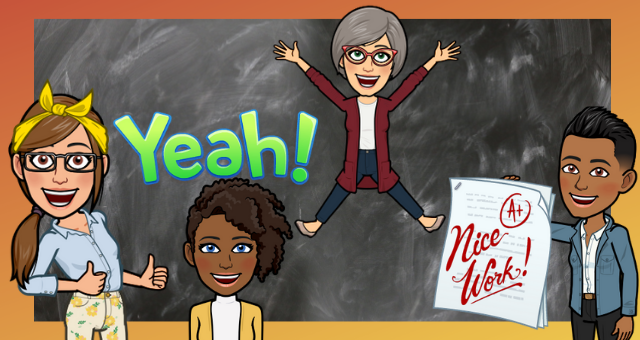Trying new things and staying connected to students is of utmost importance for Deidre Price, PhD, director of Instructional Technology and Online Education at Northwest Florida State College, which Price reiterated at this year’s Annual Teaching Professor Conference during her session. In order to keep her students engaged and incorporate a sense of humor into her classes, Price uses a combination of Bitmojis, Gifs, and other social media tools to provide her students with positive reinforcement.
An Extra ‘Bit’ of Encouragment
A Bitmoji, an avatar in which you create yourself, “can be empowering,” says Price. “It’s this other persona you’re adopting, and you can personalize it and make it into a cartoon version of yourself.”
Once your Bitmoji has come to life and you’ve personalized its clothes and facial features, the app automatically creates stickers of your avatar performing different actions.

“I frequently use this tactic,” says Price. “I can respond to student emails with Bitmojis super-fast if it’s built into the Chrome browser.”
For instance, if Price receives an assignment that’s been submitted via email, she can send an encouraging Bitmoji to indicate the student has done a great job. Rather than typing out a response, Price can find an appropriate Bitmoji sticker and send it directly to the student.
But there’s always a time and place for these fun avatars. “They’re best used for positive reinforcement,” she says. “They can be funny and sarcastic if you’re using them to nudge students along, but I do recommend that you understand where your context is coming from.”
Most times Price uses Bitmojis to say, “Great job!” to students on an assignment or quiz. She also uses them to send reminders, while other times she checks in to make sure everyone is doing okay, or finds a celebratory avatar for the last day of class.

In one instance, Price used Bitmojis with a class of 77 students. She was interested in previewing each student’s thesis statement before they began writing their final version. In response, she front-loaded the assignment and said, “If I send you back your thesis statement with the word ‘Approved,’ think fireworks. It means you blew me away, and I’m celebrating and basking in your glory.”

With an “Approved” Bitmoji, Price created an easy-to-follow format for students and a time-saver for herself. If she offered suggestions rather than saying, ‘Approved,’ it only meant the student needed to take a few extra steps in perfecting their thesis statement.
“You can almost create a legend of what you mean when you send out your response,” she says. “But always encourage…don’t discourage.”
Oh Snap!
Although Snapchat can be used to create Bitmojis, Price also suggested using Snapchat to create “Snap stories” for students. “These take longer, and this method focuses on the creation of content,” she says.
For instance, if a professor wanted to create a Snapchat story that was only available to their students, they could create a short video on a specific topic, such as Tips and Tricks for Studying. In this case, the professor would need to set up a specific Snapchat account that only their students could follow.
Additionally, Price recommended making sure students are given guidelines so they use the Snapchat avenue as a proper venue for learning.
What Do You Meme?
Price also uses Gifs and memes in the classroom. It’s easy to create your own Gif or meme using a picture of a TV/movie character combined with a class-appropriate word or phrase. These can also be turned into short animations.

Price says she uses her favorite shows or movies as inspiration to create funny and motivating Gifs or memes for her students.
“Sometimes they’re in awe of the fact that I own a TV,” she says.
Again, when creating these, Price reiterated that seriousness and sensitivity are key when issuing appropriate messages. These elements can add an element of humor to the classroom, but it’s important these tactics emulate laughter with students and not at students.
Serving a Purpose
Whether it’s incorporating Bitmojis, Snapchat, Gifs, or any other social integration into the classroom, Price recommends incorporating one thing at a time so it doesn’t take a lot of cognitive load. These interactive tools are meant to clarify, not confuse.
“Just use the one thing that represents you,” she says. “If you’re doing something dramatically different from other faculty, let them know why. Also, having conversation with students can be a starting point for using these tools.”
Price enjoys implementing new things into both her online and in-person classes but says it’s important to remember that not everyone knows or understands how to use these elements.
“Always remember what it’s like not to know something,” she says. “That’s key. I try to do new things often to keep me connected to that disconnect of not knowing something.”
Overall, these new additions should serve a purpose in the classroom. Sometimes students need a little extra humor integrated into their day, and a subtle funny picture or avatar may be just the trick to make sure students know you care and that you’re rooting for them to succeed.

